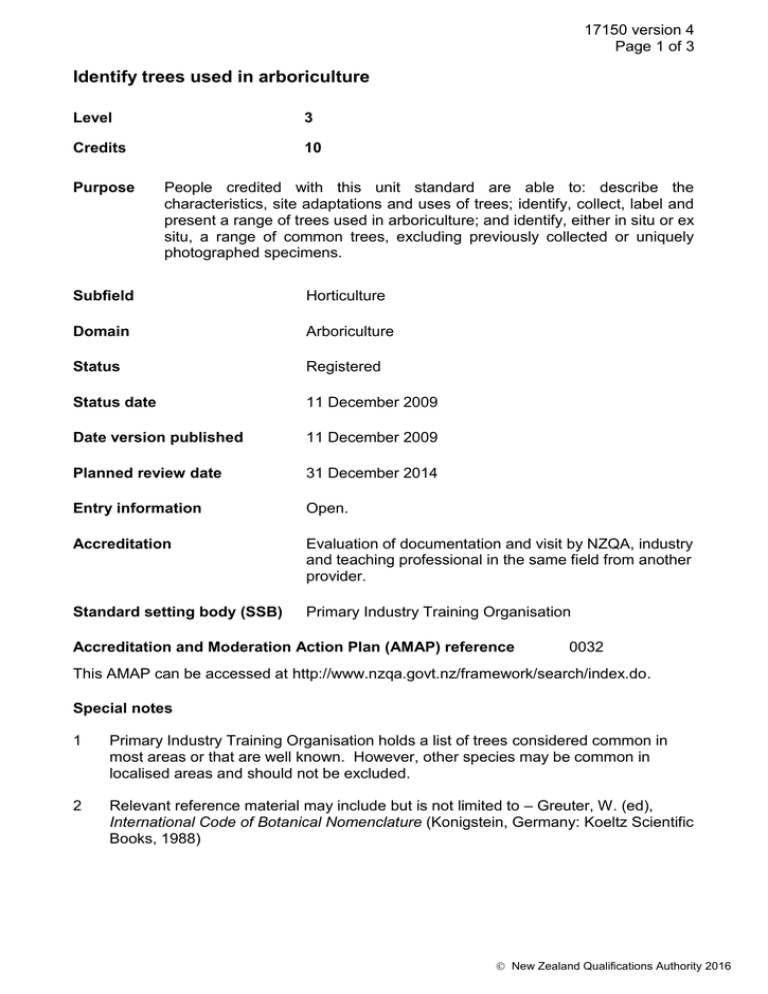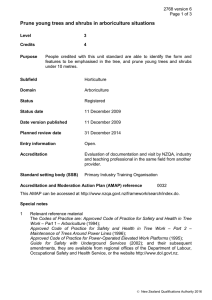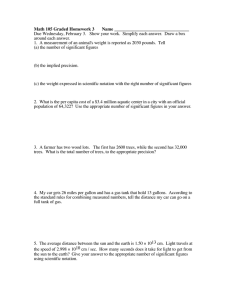Identify trees used in arboriculture
advertisement

17150 version 4 Page 1 of 3 Identify trees used in arboriculture Level 3 Credits 10 Purpose People credited with this unit standard are able to: describe the characteristics, site adaptations and uses of trees; identify, collect, label and present a range of trees used in arboriculture; and identify, either in situ or ex situ, a range of common trees, excluding previously collected or uniquely photographed specimens. Subfield Horticulture Domain Arboriculture Status Registered Status date 11 December 2009 Date version published 11 December 2009 Planned review date 31 December 2014 Entry information Open. Accreditation Evaluation of documentation and visit by NZQA, industry and teaching professional in the same field from another provider. Standard setting body (SSB) Primary Industry Training Organisation Accreditation and Moderation Action Plan (AMAP) reference 0032 This AMAP can be accessed at http://www.nzqa.govt.nz/framework/search/index.do. Special notes 1 Primary Industry Training Organisation holds a list of trees considered common in most areas or that are well known. However, other species may be common in localised areas and should not be excluded. 2 Relevant reference material may include but is not limited to – Greuter, W. (ed), International Code of Botanical Nomenclature (Konigstein, Germany: Koeltz Scientific Books, 1988) New Zealand Qualifications Authority 2016 17150 version 4 Page 2 of 3 3 Definitions Unique identifier refers to a personal identifying object in the photograph that is used to determine that individual actually took the photograph themself. In situ refers to in its original place. Ex situ refers to away from its original place. Elements and performance criteria Element 1 Describe the characteristics, site adaptations and uses of trees. Range trees from Primary Industry Training Organisation list. Performance criteria 1.1 Trees are described in terms of their identifying features. Range 1.2 size, growth rate, colour, foliage, deciduous or evergreen, significant flowers, fruiting characteristics, special features, habit, form. Any poisonous, irritant and nuisance properties are identified in terms of their effects. Range may include – flower, leaf, bark, fruit, weed potential. 1.3 Trees are described in terms of their soil tolerances and climatic requirements. 1.4 Trees are described in terms of their uses. Range may include but is not limited to – street trees, small garden, shelter belts, woodlot, erosion control, parkland, production, climate control. Element 2 Identify, collect, label and present a range of trees used in arboriculture. Range trees from current industry list during all seasons. Performance criteria 2.1 Ten common tree specimens are identified, collected, pressed, dried, and mounted neatly or photographed with a unique identifier. Range specimens or photographs are to show bark, stem, leaves, and flowers. New Zealand Qualifications Authority 2016 17150 version 4 Page 3 of 3 2.2 Each plant specimen and/or photograph is labelled and presented. Range label includes – botanical, family and common name; identifying features; plant type; plant use; cultural requirements; location of the plant. Element 3 Identify, either in situ or ex situ, a range of trees, excluding previously collected or uniquely photographed specimens. Performance criteria 3.1 Trees in arboriculture are identified either in situ or ex situ. Range 100 out of 115 from the Primary Industry Training Organisation list; identification includes – botanical and common names given for each; identifying features; plant use. Please note Providers must be accredited by NZQA, or an inter-institutional body with delegated authority for quality assurance, before they can report credits from assessment against unit standards or deliver courses of study leading to that assessment. Industry Training Organisations must be accredited by NZQA before they can register credits from assessment against unit standards. Accredited providers and Industry Training Organisations assessing against unit standards must engage with the moderation system that applies to those standards. Accreditation requirements and an outline of the moderation system that applies to this standard are outlined in the Accreditation and Moderation Action Plan (AMAP). The AMAP also includes useful information about special requirements for organisations wishing to develop education and training programmes, such as minimum qualifications for tutors and assessors, and special resource requirements. Comments on this unit standard Please contact the Primary Industry Training Organisation http://www.primaryito.ac.nz if you wish to suggest changes to the content of this unit standard. New Zealand Qualifications Authority 2016





